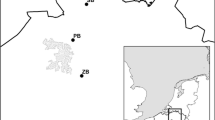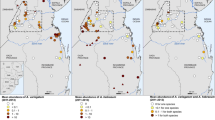Summary
Competition for sites of attachment to hosts by three species of reptile tick, Aponomma hydrosauri, Amblyomma albolimbatum and Amb. limbatum was investigated as a possible cause for the parapatric distributions found in these species throughout southern Australia. Two localities were chosen for detailed study; a boundary between Ap. hydrosauri and Amb. limbatum near Mt. Mary in the mid-north of South Australia and a boundary between Ap. hydrosauri and Amb. albolimbatum near Arno Bay on the Eyre Peninsula of South Australia. Comparisons of sites of attachment to hosts were made between hosts infested by one species of tick and hosts infested by two species of tick. At Mt. Mary, Ap. hydrosauri and Amb. limbatum adults attach more commonly in the ears and on the midback of their hosts, however, no evidence was found to suggest that competition between the species occurred for these sites. At Arno Bay, Amb. albolimbatum adults had similar sites of attachment to hosts as the other two species, however, significantly more of this species attach in the ears of their hosts. There is no difference in sites of attachment to hosts of Ap. hydrosauri females at Arno Bay and Mt. Mary. Ap. hydrosauri males at Arno Bay, however, show a shift in sites of attachment to hosts away from those sites occupied by Amb. albolimbatum males and females. This shift occurs only in cases where Amb. albolimbatum did not infest the same host. Although the shift in male Ap. hydrosauri sites of attachment to hosts can be explained in terms of past competition, there is no evidence to suggest that such competition in the past, or competition at present, maintains the parapatric boundaries found in these species of thick.
Similar content being viewed by others

References
Andrews RH, Bull CM (1980) Mating behaviour in the Australian reptile tick Aponomma hydrosauri. Anim Beh 28:1280–1286
Andrews RH, Bull CM (1981) Attraction of males to females in the mating behaviour of three reptile tick species. Anim Beh 29:518–522
Bovbjerg RV (1970) Ecological isolation and competitive exclusion in two crayfish (Orconectes virilis and Orconectes immunis). Ecol 52:225–236
Brown JH (1971) Mechanisms of competitive exclusion between two species of chipmunks. Evol 52:305–334
Bull CM (1978) Heterogeneity of resource utilization in a population of the Australian reptile tick, Aponomma hydrosauri (Denny). Ecol Ent 3:171–179
Bull CM, Sharrad RD (1980) Seasonal activity of the reptile tick, Aponomma hydrosauri (Denny) (Acari: Ixodidae) in experimental enclosures. Aust J Ent Soc 19:47–52
Bull CM, Sharrad RD, Petney TN (1981) Parapatric boundaries between Australian reptile ticks. Bull Ecol Soc Aust 11:(in press)
Bull CM, Smyth M (1973) The distribution of three species of reptile tick, Aponomma hydrosauri (Denny), Amblyomma albolimbatum (Neumann) and Amb. limbatum II. Water balance of nymphs and adults in relation to distribution. Aust J Zool 21:103–110
Jaeger RC (1971) Competitive exclusion as a factor influencing the distribution of two species of terrestrial salamanders. Ecol 52:632–637
MacLeod J, Colbo MH, Madonly MH, Mivanaumo B (1977) Ecological studies of ixodid ticks (Acari: Ixodidae) in Zambia. III. Seasonal activity and attachment sites on cattle with notes on other hosts. Bull ent Res 67:161–173
Meredith DH (1977) Interspecific agonism in two parapatric species of Chipmunks (Eutamias). Ecol 58:423–430
Nelson WA, Keirans JE, Bell JF, Clifford CM (1975) Host-ectoparasite relationships. J Med Entomol 12:143–166
Randolf SE (1975) Patterns of distribution of the tick Ixodes trianguliceps (Birula) on its hosts. J Anim Ecol 44:451–474
Rosenzweig ML (1974) On the evolution of habitat selection. Proc 1st Int Congr Ecol 401–404
Rosenzweig ML (1979) Optimal habitat selection in two-species competitive systems. In: M Halback and J Jacobs (eds) Population Ecology. Gustav Fisher Verlag, pp 283–295
Satrawaha R (1980) Ecology and activity patterns of the lizard Trachydosaurus rugosus. Unpubl M Sc thesis. School of Biological Sciences, Flinders University
Schoener TW (1974) Resource partitioning in ecological communities. Sci 185:27–39
Sharrad RD (1980) Studies of factors which determine the parapatric distributions of three species of South Australian reptile ticks. Unpubl Ph D thesis, Adelaide University
Smyth ML (1973) The distribution of three species of reptile ticks, Aponomma hydrosauri (Denny), Amblyomma albolimbatum (Neumann), and Amb. limbatum (Neumann). I. Distribution and hosts. Aust J Zool 21:91–101
Taylor LR, Woiwood IP, Perry JP (1978) The density-dependence of spatial behaviour and the rarity of randomness. J Anim Ecol 47:383–406
Weallers WW, Marganeidge KR (1971) Cutaneous vascular responses to temperature change in the spiny-tailed Iguana, Ctenosaura cemilopha. Copeia 1971:548–551
White FN (1976) Circulation. In: C Gans and WR Dawson (eds) Biology of the Reptilia 5:275–334, Acad Press
Author information
Authors and Affiliations
Rights and permissions
About this article
Cite this article
Andrews, R.H., Petney, T.N. Competition for sites of attachment to hosts in three parapatric species of reptile tick. Oecologia 51, 227–232 (1981). https://doi.org/10.1007/BF00540606
Received:
Issue Date:
DOI: https://doi.org/10.1007/BF00540606



